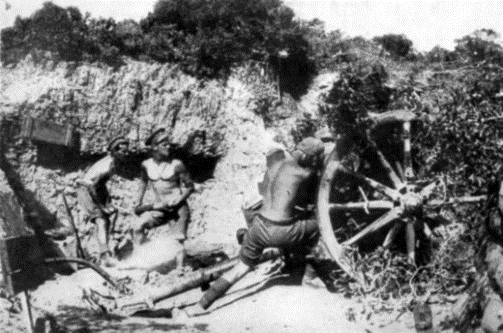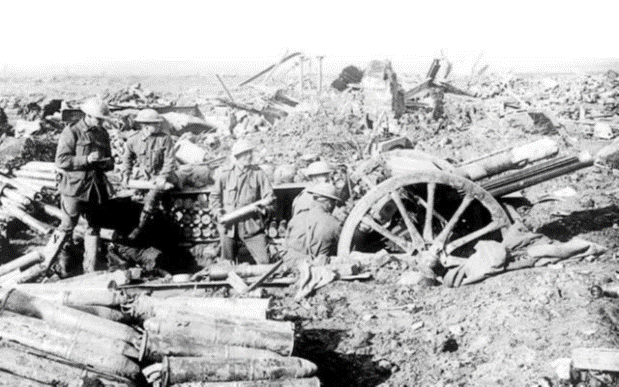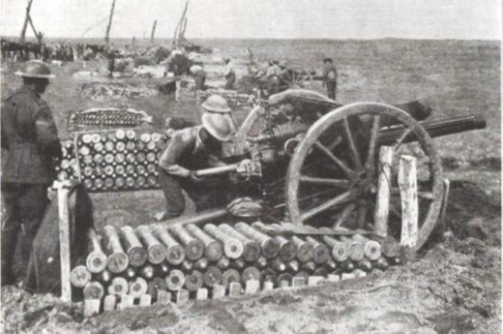From having just three field batteries in 1913, Australian artillery had increased by 1918 to number 1200 guns on the Western Front. The workhorse was the 18-pounder QF field gun which fired shells with a relatively flat trajectory to almost 5000 metres; integrated with each three batteries of 18-pounders would be a battery of 4.5-inch QF field howitzers, firing with a more elevated trajectory, to almost 6700 metres. These field guns were pulled around by six-horse-teams and operated by 10-man crews. (There was also the Heavy Artillery Group which operated the 8-inch BL howitzer, firing 90kg shells, and the 9.2-inch BL howitzer, which fired 130kg shells, with ranges of from 9600 to almost 13,000 metres. These needed tractors to pull them around and were operated by 12-man crews.)

Hardback ix, 480pp. RRP $34.99
In the first half of the war Australian gunners had available to them mainly shrapnel shells, which were detonated above their target by powder-burning time fuses, bursting in the air to spray hundreds of metal balls downwards – but they were only really lethal against enemy troops if they were unlucky enough to get caught out in the open, not in the safety of deep trenches. Gradually shrapnel would be replaced by HE (High Explosive) shells, which were intended to explode on impact with the ground, but initially this was not instantaneous, with detonation usually occurring after a delay, resulting in cratering and a contained explosion – it was only from early 1917 that ‘graze’ fuses maximized the destructive effect.
Australian historians have written relatively little about the AIF’s artillery. The explanation dates from the Official History of Australia in the War of 1914-18: under the direction of Charles Bean, it focused attention on the Australian infantryman, presented as the epitome of the national character, and devoted minimal attention to the technical aspects of warfare such as those raised by the ‘gunner’s war’. A strong argument can be made that Bean’s emphasis was misplaced – because it was really the artillery that decided the war’s outcome. For those historians who argue thus, the centenary of the war presented an opportunity to set the record straight. A seminar series was arranged, ‘Firepower: Lessons from the Great War’, conducted across eleven sessions between 2015 and 2018. These involved the presentation of papers by individuals from a variety of backgrounds which, while paying some attention to the Australian Field Artillery, gave rise to a broad ranging conversation – about the evolution of, indeed ‘revolution’ in, techniques which would see artillery ‘shaping’ the course of the conflict. Subsequently the best contributions have been selected for publication as Clash of the Gods of War: it incorporates the papers of 22 authors, appearing as individual chapters. What results is a complex discourse, about the emergence of a new style of warfare – and of how Australians were involved in that process. It is not a book about heroic Aussie exploits.
Battlefield success in the First World War would be largely dependent upon infantry receiving effective, overwhelming artillery support. Such support was a prerequisite if they were to capture enemy positions. As demonstrated by the 1915 Gallipoli campaign, when it was absent fighting could readily degenerate into trench gridlock. Lacking artillery support, the 25 April 1915 dawn landing at Anzac Cove turned into a fiasco. There was some support from British naval gunnery offshore, but because of the close proximity of the opposing forces the Turkish defenders could not be targeted. It was not until 10 am that a single gun battery (manned by Indian troops) was landed and at 11:55 am three of its guns opened fire; but because of Turkish counter-battery fire they had to be withdrawn three hours later. At 5:45 pm four more (Indian-manned) guns were put into operation; and at 6 pm a solitary Australian-manned field gun began firing. By nightfall, the Australians had been confined to a shallow beachhead, (a situation which would prevail for 9 months). On the next day 19 Australian guns were landed, of which 10 were then returned to the ships – out of fear that the Anzac position would be overrun and the guns captured. It would take 13 days before five Australian field artillery batteries were ashore and in position to provide supporting fire for their troops.

A provocative interpretation, from the Turkish perspective, is provided by Professor Mesut Uyar. He argues that the British planners of the Gallipoli operation shared a common racist outlook: they were convinced of the ‘racial superiority’ of the troops they were landing on the peninsula, and that ‘the Ottomans would “melt away” when they saw the British flag, and witnessed the might of the Royal Navy and the Imperial armies as they massed on the beaches’. This didn’t eventuate. ‘Ultimately, the British and Australians paid dearly for their underestimation and disdain of the Ottomans’. As regards the relative abilities of the two forces, Uyar proposes that the Turks ‘adapted to trench warfare better than the Allies’ – he argues, for example, their artillery was used more effectively in a counter-battery role.

The Australian artillery that would be deployed on Gallipoli was grossly ill-prepared for the task at hand. Pre-war training had involved individual batteries practising without any higher coordination – and when it came to actual combat, the cooperation between all available artillery assets that would have made the greatest impact could not be achieved. In one instance a request for fire support from the artillery located in another sector of Anzac took a day to reach the relevant commander. There was a ‘lack of an overarching corps artillery command and control arrangement’: unified fire plans were a work in progress. ‘… the ANZAC commanders were on a steep learning curve in relation to arranging support for assaults against entrenched positions’. That said, this was not a situation unique to the Gallipoli campaign: a not too dissimilar situation was playing out in Europe, on the Western Front – where most of the AIF would find itself next, after being evacuated from Gallipoli on the night of 19/20 December 1915.
About 70% of Clash of the Gods of War involves the war on the Western Front: of how the use of artillery evolved over the course of the conflict there. Without becoming over-technical, it is a discussion which reflects the latest research of military historians into how the British army underwent an intense and steep ‘learning curve’ to emerge a battle-winning force in August 1918. It is against this background that the AIF is viewed: on the Western Front, it was subsumed to a significant extent into the BEF (British Expeditionary Force). Key Australian artillery commanders Brigadier-General Talbot Hobbs and Major-General Walter Coxen had received formative training from the British Army. Nick Floyd observes: ‘Throughout the war, interoperability between British and Dominion forces in a technical, cultural and procedural sense yielded highly effective cooperation’; and, ‘the Australian field artillery [was] a part of and supported by the wider BEF’. David Brook: ‘Throughout the war, Australian artillery generally adopted the methods and training concepts, the armament and organisations of the British Army’. Ellen Creswell places the Battle of Hamel, famously planned by Australia’s Major-General Sir John Monash, within the context of ‘a steep and uneven learning process as the British … wrestled with how to incorporate new technologies into their existing tactics’.
When the AIF began arriving on the Western Front from mid-1916, its mentor – the BEF – was still in the very preliminary stages of coming to grips with the stalemate of trench warfare. The British Army had little experience in use of massed artillery: its battery commanders had only been trained to provide instant local fire support, using direct fire (against visible targets), supporting individual battalions experiencing problems. For its first full-scale offensive of the war, the 10-12 March 1915 Battle of Neuve Chapelle, the BEF gathered an unprecedented 340 guns, and the fighting began with an attempt to achieve surprise with an innovative, brief 35-minute bombardment. Apart from some initial objectives being taken, however, the British attackers were forced to retreat. Subsequently, the wrong conclusions were drawn: that battles needed to be preceded by days of bombardments, with the objective of obliterating front-line enemy fortifications and annihilating defenders. (This flawed belief in ‘destruction as a foundation for fire power design’ would continue to assert itself, for example in the battles in which Australians participated at Pozières in July/August 1916 and Bullecourt, May 1917.) One obvious lesson was that shrapnel shells were largely ineffective; what was needed were more heavy guns firing HE shells (both of which had been in very limited supply in 1915). Most importantly, considerable preparatory work was needed in the many weeks preceding a battle, locating enemy artillery batteries (not directly observable, many being positioned well to the rear of the battle zone) with the intention that they should be subjected to pin-point, ‘indirect’ counter-battery fire when battle was joined – they needed to be neutralised so that attacking infantry could cross no-man’s-land as free as possible from enemy bombardment. It would take until 1918 for various lessons to be properly learned, and the remedies implemented. As Meleah Hampton puts it, Australia’s General Monash ‘had the benefit of the systematic dissemination of information by the BEF, within which the Australian Corps was seated. The British Army of 1918 was heavily geared towards lesson-learning, with Stationary Service pamphlets on recent notes from attacks and lessons learnt widely distributed among commanding officers at all levels’.

The Battle of Hamel of 4 July 1918 was meticulously planned by Monash: it was ‘a limited-objective, set-piece battle predicated first on the use of artillery’, and it lasted just 93 minutes. As explained by Meleah Hampton, it was ‘one of the best exemplars’ of ‘the British offensive method of 1918 … heavily dependent on a systematic application of firepower to support advancing infantry’. Crucial to Monash’s plan were techniques that the BEF had been developing ‘from experience gathered over years of frontal assaults on a continuous and well-fortified German line’. The infantry followed behind a creeping barrage which consisted of a series of lifts of 100 yards every two or three minutes, combined with a thick smokescreen which hid the advancing infantry. Once the village of Le Hamel was reached, a standing barrage kept it isolated for 30 minutes. In total, at least 132,000 shells had been fired by 61 batteries of field guns and howitzers. Thereby German machine-gunners and infantrymen were mostly stopped from firing on the attackers. Simultaneously, 161 heavier guns were devoted to counter-battery fire. For this purpose, since 1915 the BEF had been developing scientific methods for locating enemy artillery batteries: flash-spotting and sound-ranging – the latter technique having been perfected by an Australian, Major Willy Bragg. Using these techniques, in the days leading up to the battle the ‘German positions had been precisely located’, and just as the battle began, ‘a sudden burst of counter-battery fire proved to be devastatingly accurate … The attacking Australian infantry … experienced almost no fire from the German artillery during the assault’. During their advance across No-Man’s-Land, the troops were closely supported by another example of new technology which had been developed by the BEF, the tank. And overhead, the attack was supported by aircraft. Such was the success of Hamel as a trial of the new ‘British offensive method’ of all-arms warfare, that at the end of July a pamphlet was published outlining what had occurred. It served as a model for the 8 August Allied attack at Amiens which was so successful that Ludendorff described it as the ‘Black Day of the German Army’.
The battle-winning formula arrived at in 1918 is analysed in a chapter by Albert Palazzo. He draws particular attention to a newly created agency, the Counter Battery Staff Office (CBSO). The first was established in July 1916, and soon every BEF corps had its own CBSO, commanded by a lieutenant colonel with a small staff of artillery and intelligence officers. Palazzo: The CBSO linked a variety of sensors with planners who used the information to develop gunfire programs which its staff assigned to batteries to conduct. By using the CBSO system of fire management, the British and French guns became much more effective at counter-battery firing and gained the ability to silence the enemy’s artillery at the point and time of their choosing. With the enemy’s guns silenced, the infantry could now advance in the wake of tanks and a rolling barrage in relative security.
Clash of the Gods of War is a book of uneven quality. Some chapters are content-heavy, but others like that by Palazzo are full of interesting ideas and stimulating analysis. It is not a book especially about the AIF. But for anybody wanting to have an up-to-date understand of how the stalemate of trench warfare was eventually overcome, it is recommended reading.
Reviewed by David Martin for Reconnaissance, The Magazine of the Military History Society of New South Wales Inc
Contact MHHV Friend about this article.






